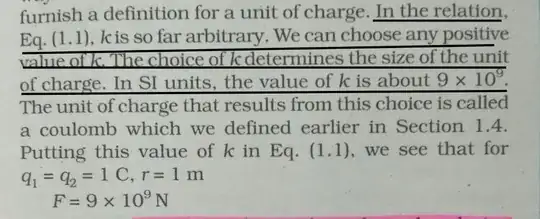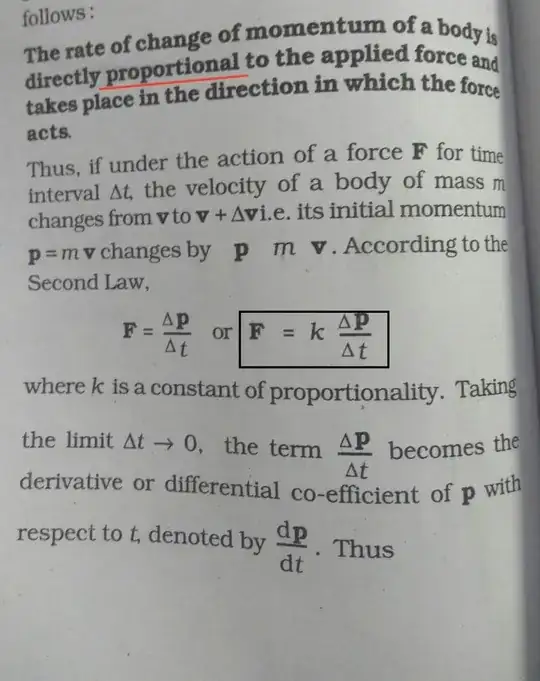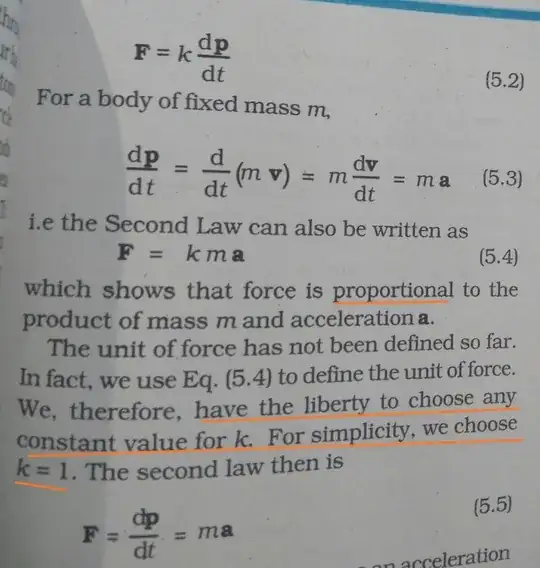Just as in Newton's 2nd law the value of constant was completely arbitrary (as said in ncert textbook class 12 physics) and was chose to be 1.
Why not Coulomb's constant is chosen as unity?


- 137
5 Answers
You can choose the value you want for your constants. It will only change the units you are working on. In fact, there are already systems of units where Coulomb constant is 1. Search about Hartree or Gaussian units.
One difference between Newton’s second law and electrostatic force is that the second law is the defining equation for force. Thus we can set the proportionality constant to anything. But in Coulomb’s law the LHS already has well defined units. $$F\propto\frac{q_1q_2}{r^2}$$ And in the RHS, if we stick with metres for distance, we have control over the value of a unit of charge. Now if that’s also taken to be SI (coulomb) then the only way to have consistent magnitude of units between the LHS and RHS is to define the constant of proportionality accordingly.
In short, the proportionality constant takes on whatever value that equates the (magnitude of) LHS and RHS.
- 9,511
So as others have noticed, it can be chosen as unity, or to have a particular value.
The SI units do not, because they wanted to have a much more practical unit of measurement of the form “if you run a current of $10~\text{A}$ between these two wires, they will attract with a force of $2 \text g\cdot\text{cm}/\text s$ per cm of wire length.” That number in turn was already in use before the SI units came around, so it was chosen for easy interconversion.
This practical method effectively set the magnetic constant as $\mu_0 = 4\pi \times10^{-7}~\text{kg}\text m/\text C^2,$ and then the electric constant cannot be set independently but must become $\epsilon_0\mu_0 =1/c^2$. As a result the force constant $k_\text E=1/(4\pi\epsilon_0)$ is forced to be $c^2/10^7$ in SI units. So that is where your wonky number is coming from.
If you are designing your own units as a fun exercise, do not be too quick to set this number to 1! I actually like the value of $4\pi r^2$ in the denominator of the force law as it indeed refers to the surface area of an important sphere. But as a practical point there is a tension here between your unit of potential, the volt-equivalent, and your unit of current, the amp-equivalent. One volt is a very convenient unit of potential, and one milliamp is a very convenient unit of current.
I have observed that one can bring this ratio more into line by choosing instead $k_\text E=c/(4\pi)$ or so, shifting a factor of $c$ off to the magnetic permeability equivalent and casting Maxwell’s laws as $$ \begin{align} \nabla\cdot E&=c\rho&\nabla\times E& =-\dot B/c\\ \nabla\cdot B&=0&\nabla\times B& =J + \dot E/c \end{align}\\ F=q \left(E + \frac v c \times B\right) $$ which is very pretty.
In addition if you use units which fix the speed of light to be some power of 10 then you can fix the unit of electrical charge so that an electron has a power of 10 times that charge, and the constraint from normalizing the above force law gives you one more degree of freedom between your units of time and mass. One would typically use this to fix Planck’s constant to a power of 10 but I might argue that a more useful-to-humanity measure would fix the average Earth day of the next thousand years to be a power of 10, so that you do not get the weird “kilowatt-hours” type of unit in practice.
- 9,511
- 39,588
In many systems of natural units, Coulomb's constant is indeed equal to one, but in S.I units it is not. Because physicists often work in S.I units rather than natural ones, it is necessary to allow Coulomb's constant to take any value, so we write it into the equation instead of simply having $F=\frac{Qq}{r^2}$.
Also, do you mean Newton's law of gravitation rather than Newton's 2nd law? It is common to set the gravitational constant equal to one, but less common to do so to an objects mass.
- 1,274
- 1
- 8
- 15
We already have definitions for force, distance, and charge. What we don't have is what nature gave us for the strength of the force of interaction between charges. We have to (conceptually) take two 1 Coulomb charges, place them 1 meter apart, and measure the force. We will find that the force is not 1 Newton, but rather 9 x 10${}^{9}$ Newtons.
- 22,633